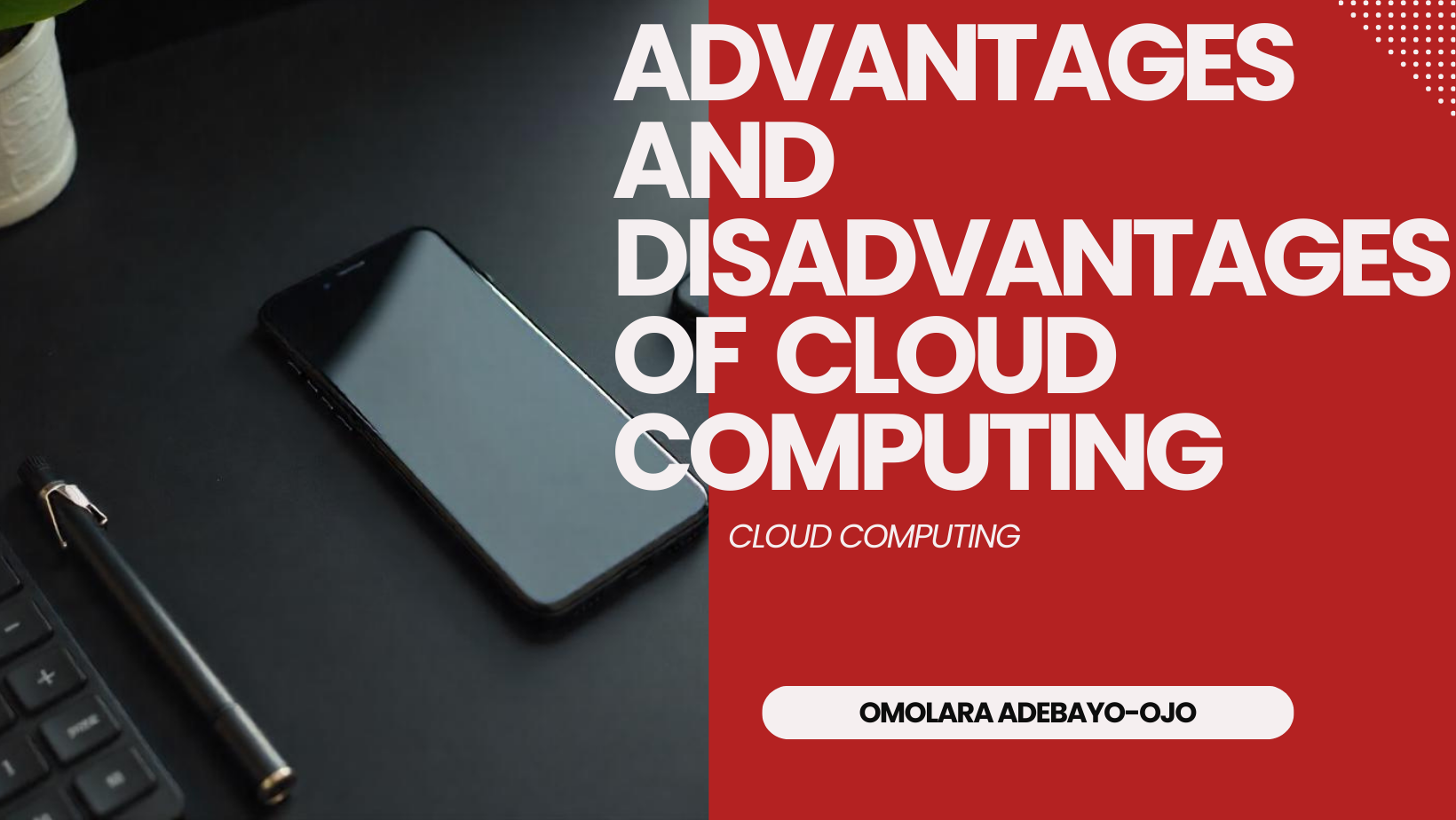Cloud Computing: Advantages and Disadvantages Explained.
 Omolara Adebayo-Ojo
Omolara Adebayo-Ojo
What is Cloud Computing?
Cloud computing is the delivery of computing services—including servers, storage, databases, networking, software, analytics, and intelligence—over the Internet ("the cloud") to offer faster innovation, flexible resources, and economies of scale.
Advantages of Cloud Computing
1. Cost Efficiency
● Reduced Upfront Costs: Minimal initial investment in hardware and infrastructure.
● Pay-as-You-Go: Pay only for the resources you use, reducing waste and optimizing spending.
2. Scalability
● On-Demand Resources: Easily scale resources up or down based on demand.
● Flexibility: Adapt quickly to changing business needs without significant delays or expenses.
3. Accessibility:
● Remote Access: Access applications and data from anywhere with an internet connection.
● Global Collaboration: Facilitate teamwork across different geographical locations.
4. Reliability:
● High Uptime: Cloud providers offer robust infrastructure with redundancy and failover mechanisms.
● Disaster Recovery: Built-in disaster recovery solutions ensure data safety and business continuity.
5. Speed and Agility
● Rapid Deployment: Quickly launch and iterate on new applications and services.
● Development Efficiency: Access to a wide range of development tools and platforms accelerates the software development lifecycle.
6. Performance
● Optimized Resources: Cloud providers use high-performance servers and infrastructure, often outperforming on-premises setups.
● Regular Upgrades: Continuous performance improvements and updates by the providers.
7. Security:
● Advanced Security Measures: Cloud providers implement strong security protocols and compliance measures.
● Data Protection: Regular backups and encryption ensure data integrity and confidentiality.
8. Innovation
● Access to Latest Technologies: Continuous access to cutting-edge technologies and services, like AI, machine learning, and big data analytics. ● Focus on Core Business: Allows organizations to focus on their core activities without worrying about IT infrastructure management.
Disadvantages of Cloud Computing
- Occasional downtime
The nature of cloud computing makes it vulnerable to server downtime. During downtime, customers are forced to wait until the connection is restored before they can access the service. Depending on how long the downtime lasts, this situation can cause critical damage to businesses. A case of how downtime can affect cloud-driven businesses was the 2020 blackout of all Google services that lasted for over an hour, leaving millions of businesses at a halt while the outage lasted.
- Limited flexibility and control
Cloud computing is run in a way that denies business owners the ability to manage and monitor the entire cloud infrastructure. This situation often leaves businesses with little or no control over their data. In addition, depending on the cloud service provider’s management policies and end-user license agreement, customers may also have limitations on how they can handle their deployments. In most cases, when such policies are in effect, customers will have limited access to what tool, application and data they can deploy on the cloud provider’s server.
- Vendor compatibility issues
The transition from one cloud provider to another in a competitive cloud computing environment has been a major bane of cloud computing. Although while subscribing to a cloud provider, businesses are assured of how seamless it is for them to migrate to other cloud service providers, experiences have shown that this is not always the case.
There are issues with compatibility as some applications working properly in one cloud platform may not be compatible with another provider. This risk makes a lot of people apprehensive about migrating their resources to other cloud providers.
- Security and threats
Although most cloud providers apply several security measures to keep hackers away from their cloud infrastructure, the incidence of data breaches indicates that cloud computing is still vulnerable to attacks. This makes storing business-critical files and crucial data in virtual data centers a potential risk.
Although these threats do not make cloud computing entirely insecure, it only shows a higher chance of successful attacks or data breaches when there is human error in cloud setup and issues with endpoint configurations.
- Latency issues
Cloud latency describes the time it takes a cloud service operator to respond to a client’s request. Cloud service latency is a serious issue in cloud computing, especially now that the world is witnessing exponential growth in data generation and connected devices.
With more data generated from these devices, there is a potential growth in the incidence of cloud service latency. The time it takes data to travel to cloud hosting centers for computation processes and back to the client side affects cloud computing. This is why modern IoT devices and smart industries are adopting edge computing as a computing model.
- It is uneconomical
Due to the high volume of data and files stored in the cloud, users require a large amount of bandwidth to access these data constantly.
Although many cloud service providers have remodeled their payment to reflect the pay-as-you-use model, it still does cost a lot to maintain a connection to cloud services. As a result, maintaining this level of bandwidth for continued access to cloud resources can be capital intensive, and not too many start-ups can afford that.
Subscribe to my newsletter
Read articles from Omolara Adebayo-Ojo directly inside your inbox. Subscribe to the newsletter, and don't miss out.
Written by

Omolara Adebayo-Ojo
Omolara Adebayo-Ojo
DevOps Engineer